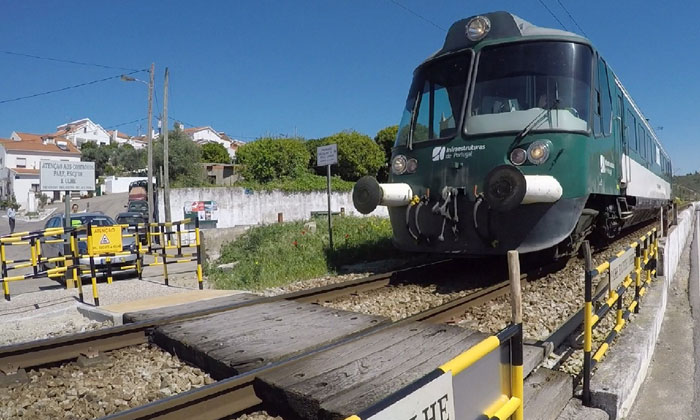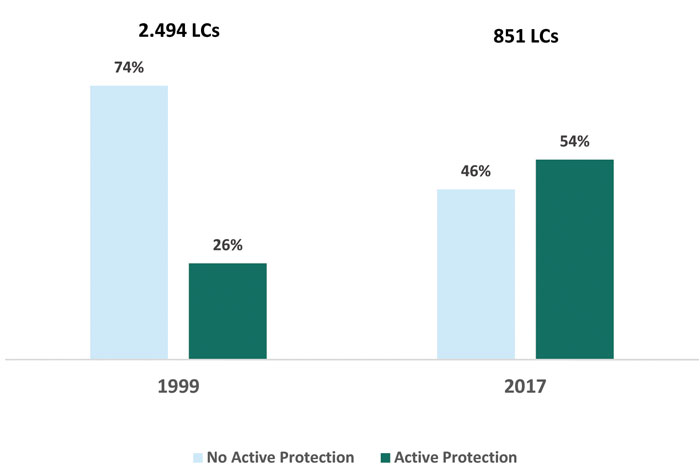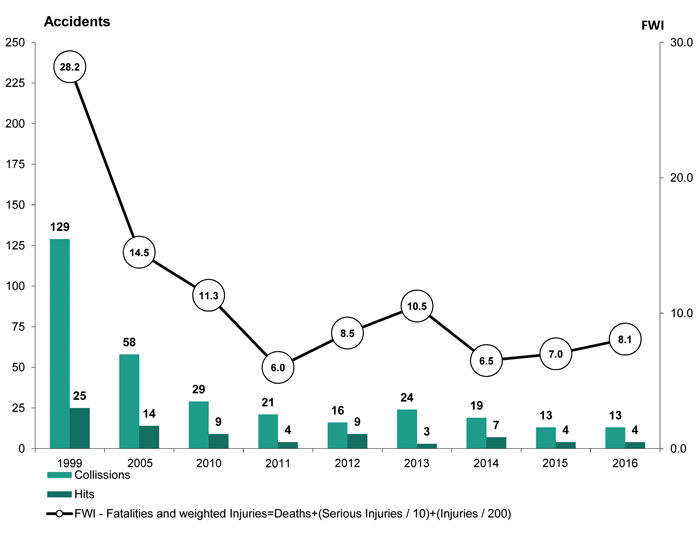Working toward a safe culture at Portuguese level crossings
Posted: 26 May 2017 | Infraestruturas de Portugal (IP) | No comments yet
In 2010 the Portuguese railway network had an operating route length measuring over 2,800km with 2,494 level crossings, representing an average of 90 level crossings per 100km of railway line. Set against this backdrop of such a high ratio of level crossings, this article outlines the significant advancements that have been made to improve safety for both road and rail users in Portugal.


Since 2010, there has been a lot of work to reduce the risks associated with level crossings and 1,643 were successfully closed by 2016 – a reduction of 65% on the total number. Additionally, investments were made in automatic protection technology that resulted in a network total of 851 level crossings; 460 (54%) having active protection systems (see Figure 1).


Figure 1: Types of level crossings in Portugal
The total level of investment over the last 17 years was approximately €350 million, which had a significant impact on overall risk factors, increasing the level of safety for users. During this time goals were defined and measures were taken to decrease the number of accidents per year at level crossings – all of which were achieved.
In 2014, a new target was defined to reduce the number of accidents by 40%, achieving less than 17 accidents by the end of 2020. In the same period, two additional objectives were identified: 65% of level crossings should have active protection, and there should only be an average of 30 level crossings per 100km of railway line.
To achieve this goal a new programme of closing and upgrading level crossings started and is currently in progress (integrated in the ‘Ferrovia 2020’ Programme to upgrade capacity on several lines).
These new objectives are the driving force for improvements at Infraestruturas de Portugal (IP) and, in fact, the rail system only encountered 17 accidents at level crossings in 2015 and again in 2016. This placed IP near their goal four years before the target (see Figure 2).


Figure 2: Number of accidents at level crossings in Portugal
Over the course of the next five years, the Portuguese investment programme in level crossings will be divided across the following three branches:
- Close continuity for 64 level crossings, mainly in urban areas
- Install Active Protection Systems at 166 level crossings across all networks
- Implement road measures to better manage the road traffic at level crossing approaches.
By the end of this programme implementation, IP expect to have achieved their goals regarding the total number of level crossings (an average of just 30 for every 100km of railway line) and having 75% of level crossings with active protective systems – all with an investment amount of €54 million.
Despite the positive results already achieved in the number of level crossings accidents, the number of fatalities and serious injuries did not have the corresponding decrease. The major accidents occurred at automatic level crossings and in the last three years were over 50%, yet in 2016 the figure rose to 76% at these types of level crossing, showing an increase of such accidents. The safety performance report recorded that three pedestrians and five vehicle drivers died at level crossings with active protection in 2016.
The major cause of accidents at active protection level crossings is a considerable number of users ignoring level crossing signs, demonstrating disrespect and negligence over the safety information. The increase in death numbers points to the intensification of this behaviour, which could not be completely overcome by the technical improvements made since 2000 in the railway crossing conditions.
The risk factors of users’ behaviour – drivers or pedestrians – are largely a result of the following:
- Distraction – often using mobile phones and headphones, which create difficulties in recognising the risks inherent to crossing rail tracks
- Impatience – long overall crossing closure times (related to length and speed of trains and the possibility of multiple trains) and failure to appreciate the real train speed can cause users to attempt to cross the railway when level crossings signal a train’s approach
- High speed – for crossings located on a road with a fast approach and good visibility, vehicle users might be reluctant to slow down and decide (wrongly) that they have enough time to cross in advance of the train.
On the road infrastructure side there are also risk factors that need to be mitigated:
- Level crossings’ surrounding environment – the sun being low in the sky, the curve of the road, fog, etc. can all affect visual conditions
- Substantial number of vehicles on the road – this can cause queues at level crossings and consequently vehicles can block the exit
- Poor layouts at level crossings or near them, in plan or profile – steep accesses, tight curves or junctions near level crossings can cause vehicles to be grounded or stuck.
The aforementioned risk factors are not solved by the traditional solution of level crossings automation, and some are increased by the continuity of urban level crossings, as well as in higher speed sections of the railway, both with greater potential to cause death or serious injury in the event of an accident.
To mitigate these risk factors, a different approach is needed: implementing a road risk assessment and level crossings measures, with reinforcement of road/level crossings signalling and innovative measures, such as the following:
- New vertical and horizontal signs when approaching level crossings, reinforcing the traditional signs
- Physical traffic separation, combined with horizontal line stops at both sides of the level crossing
- Limitation of car speed in case of level crossings having reduced visibility, associated in some more serious cases with traffic lights
- Black boards placed behind the level crossings’ red lights, for enhanced visibility in case of low sun situations
- Reinforcing the difference between the road and the railway cross, by changing the colour of the level crossings’ pavement and access
- Creating specific paths at the level crossings for pedestrians, associated with obstacles at level crossings’ entrance to guide them and avoid inappropriate behaviour
- Innovative pavements to prevent cyclists from falling at level crossings when road and tracks have similar bearings.
In conjunction, IP continues to run an awareness campaign known as ‘Stop, Listen, Look’ which started in 2006 and is dedicated to targeted communication about behaviour risks at railway crossings. Under this campaign, the two last actions were:
- A summer safety campaign at level crossings which consisted of placing bilingual posters with the slogan ‘Do not ruin your holidays’ at all level crossings near beaches and other types of summer resorts. The aim was to alert level crossing users to the dangers of rail during their holidays, when they often have a more relaxed behaviour
- A campaign for walkers which is mainly dedicated to Fátima and Santiago de Compostela pilgrims, and aims to draw individuals’ attention to crossings and avoid repeating wrong behaviours.
It’s our conviction that level crossings will always exist – mainly in pedestrian form – so it is important to continuously maintain a level of communication, using images and changing environment conditions, to ensure users maintain the necessary awareness and pay attention at cross railway infrastructure.
The implementations of this strategy, technical measures and awareness campaigns, as well as the involvement and cooperation of other institutions and stakeholders, will be crucial to achieving success in the years to come.



